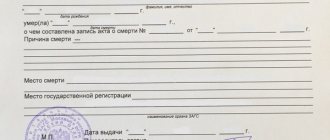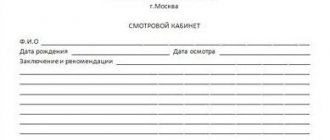Documents that confirm relationship
To understand what documents confirm kinship, you need to know that they include several groups of official papers. Among them:
- Certificates issued by civil registry establishing or changing the status of a person. The group includes birth certificates, marriage registration certificates, changes of first and last names. These documents must be kept by the citizens to whom they were issued. In case of loss or damage, they must be replaced by pre-paying the state fee.
- Certificates from the Civil Registry Office, confirming the fact of relationship. These may include certificates of birth, death, marriage or divorce, and others. The application can be submitted in person, by mail or using the services of a representative.
Attention! Certificates and certificates issued by the registry office are not the same thing. The first ones are issued once - upon the appearance, change or termination of a legal fact (birth, death, marriage, divorce). The exception is when the document is lost, in which case it is reissued. Certificates can be issued an unlimited number of times.Example : A mother is required to confirm the presence of children in order to receive a pension benefit. Her child is an adult and lives abroad; there is no way to transfer the birth certificate. The mother will not be able to obtain this document even when applying to the registry office, but she may be given a certificate of the birth of the child. With it, she has the right to apply to the Pension Fund.
- Court orders confirming or changing familial relationships. These include decisions on establishing maternity and paternity, and adoption. At the meeting, the court considers direct and indirect evidence of kinship, and on its basis makes a decision that can be challenged.
- Expert opinion . Compiled after an examination to verify consanguinity. The analysis is carried out during the proceedings in court and is ordered by the judge in the absence of sufficient documentary evidence. However, the parties can also request an examination, for example, DNA analysis.
In addition to the above official documents, proof of relationship can be :
- Testimony - even if they are not reliably informed about the presence or absence of family ties, but based on what they saw/heard earlier they can draw any conclusions about this;
- Personal correspondence, notes;
- Photos and videos from family archives;
- Medical records and certificates, extracts;
- Certificates of family composition, house books;
- Other documents that can be used to determine the presence of a family relationship.
Reference! Information from these sources is considered indirect evidence. It is not enough to confirm the relationship, but it can be provided to the court as a basis for a claim to establish the fact of relationship.
Before you can prove your relationship with deceased people, you will need to collect a whole set of documents . It depends on who the deceased is :
Free legal consultation
+7 800 350-51-81
- Parents – their passports, birth certificates (parents and child applicant);
- Spouse – marriage certificate;
- Grandmothers/grandfathers – birth certificates of father (mother), grandmother (grandfather) and the applicant, their passports;
- Sisters/brothers – birth certificates of the brother/sister and the person applying.
If relatives or persons wishing to confirm kinship have changed their names and surnames throughout their lives, this fact must be documented. To do this, along with other documents, you must provide a marriage certificate, a change of surname, first name (depending on the basis for the change in data).
Important! When documents confirming relationship with the deceased are presented to obtain property rights, they will need to be supplemented with a death certificate.
How to prepare papers
Documents confirming relationship are issued by the civil registry office. An interested person may request a duplicate (i.e., a duplicate document) from the territorial authority. You should contact the registry office in which the civil status was registered (birth, death, marriage, adoption).
If such a “branch” is located far away, you can also contact the registry office at your place of residence. In this case, the documents will be transferred within the department. But obtaining a second certificate is not always possible. And instead, the registry office will issue a certificate. For example, if a marriage has already been dissolved, the certificate of its conclusion is not re-issued.
Another obstacle is a complete refusal to issue the required document. This happens most often when nephews who inherit in the order of presentation apply for a duplicate (certificate). Also, a refusal can be issued if the applicant is the brother or sister of the testator. But this rarely happens.
Olesya L.’s half-brother, who was officially adopted by her father, died. She turned out to be the only heir, since their parents died earlier. The girl turned to a notary, who requested documents confirming the family relationship. But the registry office did not issue the necessary papers. Olesya turned to a lawyer for help. The lawyer suggested that she go to court to establish the relationship.
But in the absence of documents confirming the relationship, the notary will not formalize the inheritance. Consequently, the representative of the second line of inheritance will have to prove his right in court.
Situations when it is necessary to confirm relationship
There are many situations when it may be necessary to confirm family relationships. Among them:
- Receiving an inheritance from a deceased relative;
- Organization of a funeral (burial, registration of a related burial, compensation for the costs of this work);
- Filing claims in court ;
- Registration of social benefits;
- Confirmation of citizenship and obtaining a residence permit in Russia;
- “Preferential” conclusion of a gift agreement (without having to pay a state fee).
Attention! The list is not closed, but contains some of the most common situations requiring confirmation of a family relationship.
The most popular reason that forces citizens to prove kinship is inheritance . When the deceased did not leave a will, his property is transferred to the heirs “by law” - parents, children, spouse and others in order, according to the current rules. To enter into inheritance rights, relatives must submit documents confirming their relationship to a notary.
The second most common reason is establishing paternity . It must be confirmed in order to collect alimony from the child’s father and to be able to inherit from the father even if there is a will.
Confirmation of relationship through court
A more difficult task faces the heirs if the documents have not been preserved and the archives were lost or during military operations or natural disasters. The same difficulties arise with the death of a biological parent who did not recognize the child during his lifetime. How to prove kinship when entering into inheritance in this case? There is only one way out: an appeal to the court of first instance. The procedure takes place in several stages:
- preparation of a statement of claim to establish kinship;
- collection of necessary documents serving as proof of relationship;
- payment of state duty;
- submitting a claim to court;
- consideration of the claim on its merits;
- adjudication;
- transfer of the court verdict to a notary.
Statement of claim
In accordance with the Code of Civil Procedure of the Russian Federation, a statement of claim must be drawn up in writing according to the established form, the form of which can be downloaded here.
The introductory part states:
- name of the court and its address;
- Full name of the applicant and his registered address.
The narrative must include:
- indication of the degree of relationship with the deceased;
- steps taken to establish kinship with the help of government agencies;
- reasons for the negative result (there must be supporting certificates from the registry office and (or) archive);
- documents and witness statements (full information about witnesses is provided).
The final part of the application, the petition, states:
- what the plaintiff wants to get during the trial;
- what witnesses are proposed to be called;
- full list of attached documents.
The application must be signed indicating the date of preparation.
Documentation
The package of documents submitted to the court includes:
- a certificate from the registry office confirming the impossibility of issuing the required document;
- plaintiff's birth certificate;
- certificate of marriage or divorce if the surname has changed;
- certificate of change of surname and (or) name by the plaintiff;
- receipt of payment of state duty;
- family photos;
- evidence-based audio and video files;
- extract from the house register;
- family tree (if compiled);
- witness statements;
- extracts from the personal files of relatives;
- letters, greeting cards and notebooks;
- medical records;
- DNA tests and other evidentiary documents.
Important: if the relationship of first-degree relatives is proven, and a DNA test cannot be done, the court may decide to exhume the corpse in order to obtain biomaterial directly from the cemetery.
Government duty
The amount of all types of duties is established by the Tax Code of the Russian Federation. For claims to prove kinship, the amount is set at 300 rubles (Article 333.19, paragraph 3, part 1 of the Tax Code of the Russian Federation).
Filing a claim
Based on Art. 266 of the Code of Civil Procedure of the Russian Federation, the claim is filed in the district court at the place of residence of the plaintiff or at the location of the real estate, if, simultaneously with establishing kinship, the applicant asks to confirm the fact of ownership and use of real estate.
Consideration of the claim on its merits
There are no court hearings as such when considering cases to establish family ties. The judge considers the evidence without the applicant and witnesses (they are called to court as a last resort).
Therefore, in the statement of claim, it is important to correctly formulate the evidence and support it with papers, photographs, testimony of witnesses, etc. The application also indicates a request to conduct a DNA test with a buried relative, because There may be no other options to ask the court to exhume the body.
Adjudication
Based on the results of the consideration of the case, the court makes a decision on two issues:
- whether the applicant is a relative of the testator;
- what legal consequences arise in the event of a positive decision on the claim.
The court's verdict in writing is delivered to the plaintiff personally, sent by mail or issued to a representative who has the appropriate power of attorney.
If the applicant disagrees with the court's decision, he has 10 days to file an appeal to a higher court.
Transferring the decision to a notary
The newly recognized relative, together with a package of necessary documents, transfers the court decision to the notary. If certificates of inheritance have been issued, they are all revoked. The division of the inheritance base is carried out in a new way, taking into account the new heir.
Where and how to get the necessary papers
If the document is not in hand, it is very tattered or has errors, then the citizen can contact the registry office . It is possible to submit an application in one of the following ways:
- By visiting the establishment in person;
- Through MFC;
- Using the State Services website (if you have an authorized account).
Then the citizen pays the state fee , submits the application and receives the papers again . The period within which the authorities will issue a document confirming the relationship depends on the method of application:
- If you visit in person, you can receive the paper on the same day ;
- If the applicant submitted a request for re-issuance of certificates to the MFC , then he will be able to pick them up within 3 days ;
- When submitting an application online on the State Services website, more than a month for the requested documents .
Reference! The registry office is contacted when you need to obtain certificates for relatives. Then, along with the main package of documents, a power of attorney is submitted. If a certificate is required in the name of a deceased relative, then the power of attorney is replaced by a death certificate.
The same institution issues certificates of marriage and birth. If you need to receive a certificate containing information about another person, you need to confirm your relationship with him.
A court settlement is a last resort to obtain a document proving the fact of relationship. The procedure for appeal is established by Article 265 of the Code of Civil Procedure of the Russian Federation :
- The application is submitted only after a corresponding request has been made to the civil registry office;
- The result of applying to the registry office is a refusal due to the lack of information certifying the relationship.
If this condition is met, the judge accepts the case for consideration. In the absence of significant evidence of family relationships, the court may order the collection of extracts from archives, hear testimony from witnesses, and conduct a genetic examination. After the court makes a positive decision, the resolution can be used as an official document - a certificate of relationship.
How to prove relationship if there are no documents?
Even in situations where the heir or applicant on another issue does not have a single certificate confirming his involvement in the family, there is absolutely nothing to worry about.
Any relationship can be confirmed by contacting archives and other authorities, after which you can draw up your own tree and request supporting certificates. Also, the relationship is calmly confirmed by genetic testing.
If the notary does not have documents confirming the accuracy of the applicant’s words, then he can redirect the case to the court, which will deal with all the issues.
Results
The law provides for confirmation of kinship in several ways: by submitting existing documents and through the court. The main documents for establishing this fact are birth certificates, marriage certificates, and death certificates; expert opinions and court decisions. Witness testimony, archival materials, and personal written sources are used as indirect evidence.
If you do not have the necessary documents on hand, you must contact the registry office. A negative response from the authorities is the basis for certifying the fact of relationship in court.
Where can I get a certificate of relationship?
A certificate is one of the options to prove a blood relationship with a relative. Such a document becomes necessary in situations where there is no other way to get confirmation of your words. For example, you cannot request marriage documents if the couple has been divorced, or a child’s birth certificate if the child has been adopted.
The issued paper includes news about the registry office that issued it, information from archival records about kinship, various dates of request and issue, signatures of specialists.
It is not legally stipulated that the applicant must receive duplicate certificates. You can order a certificate at your own discretion.
Why confirm your relationship with your cousin?
Cousins refer to distant relatives. Regarding Article 1144 of the Civil Code of the Russian Federation, they can inherit property only by right of representation. For example, after the death of the testator, his closest relative turned out to be his uncle. He belongs to the heirs of the third stage, and claims to receive all the inherited property due to the absence of other applicants. Since the uncle dies before entering into the inheritance, the testator’s cousin is called to inherit, receiving his assets by right of representation.
Confirmation of family relationships with a cousin or brother is required in the following cases:
- when opening an inheritance at a notary;
- to obtain permission for burial;
- to receive compensation for funeral expenses;
- to organize a related burial.
Procedure for confirming relationship with the deceased to enter into inheritance rights
The issue of confirming kinship is paramount - especially when the inheritance is formalized by law and not by will.
A distant relative must follow the following instructions to prove his relationship with the deceased citizen:
Step 1.
Contacting a notary office. The notary must either inform you about the will himself, or you can contact him yourself. He can also tell you what documents you need to bring to formalize the entry into the right of inheritance.
Step 2.
Collection of documentation package. Below we will consider in more detail what documents can confirm family ties. Assess what documents are available and what else could be obtained as evidence.
Step 3.
Contact the authorities that can issue documents. This could be the registry office.
Step 4.
Preparation of copies of documents. It is better to keep the original documents for yourself and provide copies to the notary.
Step 5.
Provide the documents to the notary's office, where you should draw up a protocol on entering into an inheritance. A copy is usually issued. By the way, you can ask for a certificate of inheritance as confirmation.










